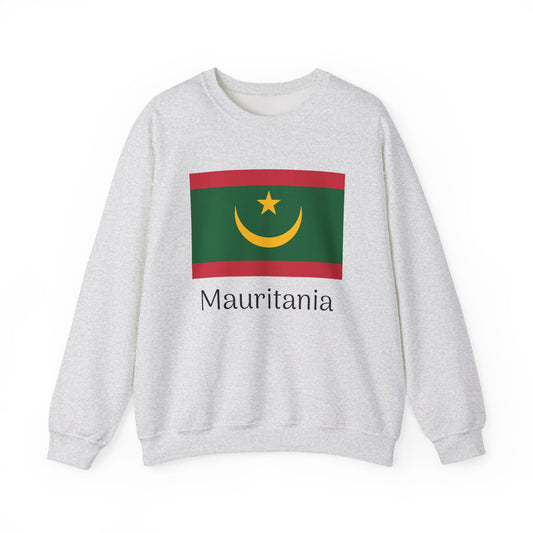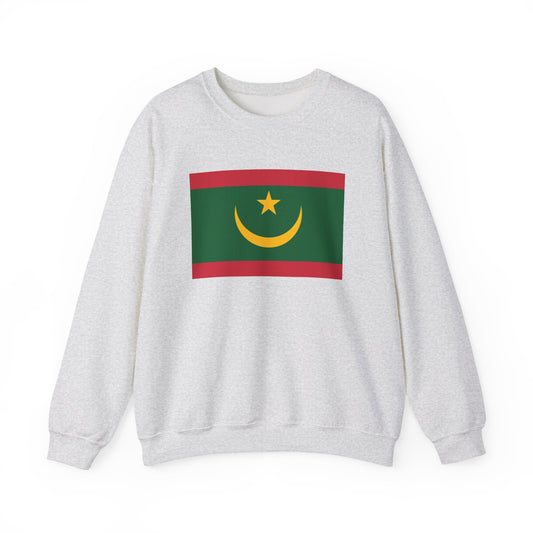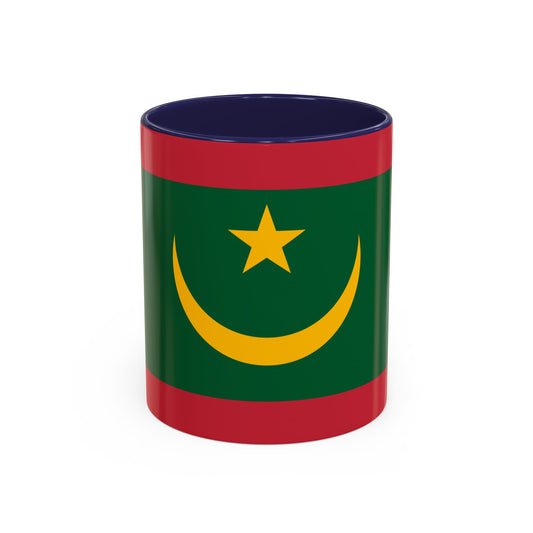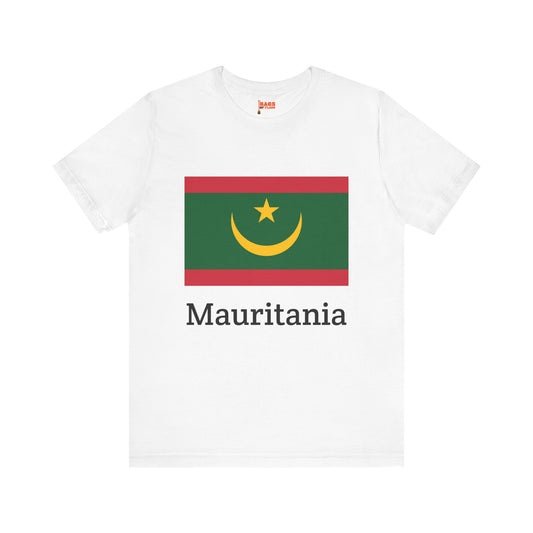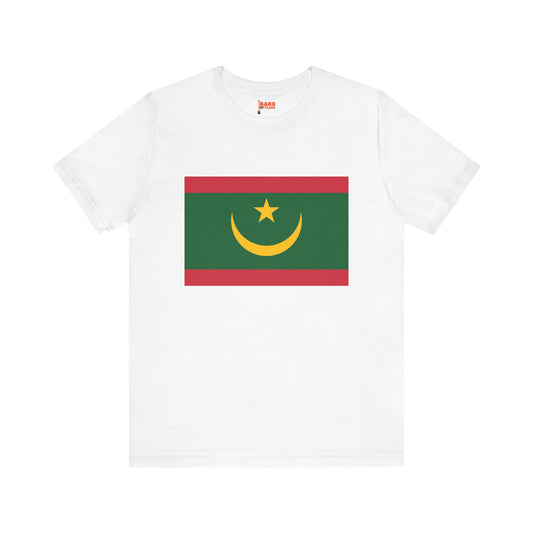-
Mauritania Sweatshirt
Regular price $34.15 USDRegular priceUnit price / per -
Mauritania Flag Sweatshirt
Regular price $34.15 USDRegular priceUnit price / per -
Mauritania Pillow
Regular price $22.65 USDRegular priceUnit price / per -
Mauritania Backpack
Regular price $59.79 USDRegular priceUnit price / per -
Mauritania Leather Patch Hat
Regular price $18.85 USDRegular priceUnit price / per -
Mauritania Mug
Regular price $11.65 USDRegular priceUnit price / per -
Mauritania Trucker Cap
Regular price $14.90 USDRegular priceUnit price / per -
Mauritania Hoodies
Regular price $34.40 USDRegular priceUnit price / per -
Mauritania T-shirts
Regular price $22.79 USDRegular priceUnit price / per -
Mauritania Flag Hoodies
Regular price $34.40 USDRegular priceUnit price / per -
Mauritania Flag on T-shirt
Regular price $22.79 USDRegular priceUnit price / per
Collection: Mauritania
The Mauritania flag, with its bold red and green bands separated by a golden yellow stripe, symbolizes pride and national identity for the West African country. Its rich history and deep symbolism reflect the values and aspirations of the Mauritanian people.
Overview of the Mauritania Flag

The Mauritania flag is a vibrant representation of the nation's heritage and values, distinguished by its unique colors and symbols. Here is a concise breakdown of its design:
- Green Band: Situated at the top, this color symbolizes growth and hope.
- Gold Band: A central stripe that echoes the expansive Sahara desert.
- Red Band: Flanking the top and bottom, these stripes commemorate the sacrifices made for independence.
- Yellow Crescent and Star: Positioned in the center against the green background, these symbols indicate Mauritania's predominant Islamic faith.
This configuration combines traditional Islamic symbolism with a nod to the nation's geographical and historical realities, making the Mauritania flag a profound emblem of national identity.
Historical Context of the Mauritania Flag
The flag of Mauritania is not just a symbol of the nation’s sovereignty but also a reflection of its historical journey to independence and its deep-rooted cultural values. Here’s a glimpse into its rich historical context:
- Year of Adoption: The flag was officially adopted on April 1, 1959, marking a pivotal moment in Mauritania's march towards independence.
- Pre-Independence Design: Initially designed to anticipate Mauritania's independence, the flag symbolized the nation’s readiness to govern itself after being a French colony.
- Designer: The flag was conceived by Moktar Ould Daddah, who later became the first President of Mauritania. It showcases his foresight and vision for the country’s identity.
-
Changes Over Time:
- The original design featured only green, gold, and the Islamic symbols of a crescent and star.
- In 2017, modifications were made to include red bands at the top and bottom of the flag. These alterations resulted from a national referendum and were intended to commemorate the sacrifices of those who fought for the country’s freedom.
-
Historical Significance:
- The inclusion of the crescent and star from the very beginning underlines Islam's importance as a cornerstone of Mauritanian society.
- The red stripes further embed the narrative of resilience and sacrifice in the nation's flag, enriching its historical context.
This brief overview encapsulates the transformative journey of the Mauritania flag, from its inception as a symbol of impending independence to its current status as an emblem of national pride, reflecting the country’s historical struggles and cultural ethos.
Symbolism Behind the Mauritania Flag

The elements comprising the Mauritania flag's design are rich in symbolism and convey the country's identity and core values. The prominent green color of the flag is not only a representation of Islam, the predominant religion but also symbolizes hope and prosperity. The golden band across the flag's center mirrors the vast expanses of the Sahara Desert, a significant geographical feature that shapes the life and culture of Mauritania. The red stripes above and below the flag denote the courage and bloodshed of those who fought for Mauritania’s independence, emphasizing a deep respect for their sacrifices.
At the heart of the flag, the crescent and star serve as universal symbols of Islam, reflecting the country's dedication to its faith. Together, these elements weave a narrative of a nation deeply rooted in its Islamic faith, proud of its heritage and the sacrifices made by its people for freedom and independence. This amalgamation of colors and symbols encapsulates the essence of Mauritanian identity, portraying a rich tapestry of cultural and religious significance.
Current Relevance of the Mauritania Flag
Today, the Mauritania flag remains a potent symbol of the nation's sovereignty, unity, and values, visible in various settings and occasions:
- National Events: It is a common sight during Independence Day celebrations, cultural festivals, and other significant national holidays, serving as a beacon of national pride.
- Government Buildings: The flag flies high on all government edifices, embodying the country's governance and the principles it stands for.
- Military Ceremonies: The flag, used in military parades and commemorative events, honors the sacrifices made by the Mauritanian armed forces.
- Educational Institutions: Schools and universities often display the flag, instilling a sense of patriotism and national identity among students.
- International Representation: The Mauritania flag represents the nation in international forums, sporting events, and diplomatic missions, showcasing its identity on the global stage.
While the flag is a source of pride for many, it has sparked debates regarding its representation of Mauritania's Islamic identity and how it aligns with the nation's secular commitments. These discussions reflect the dynamic nature of national symbols in representing a country's evolving identity and values.
Additional Facts about the Mauritania Flag
Handling and displaying the Mauritania flag comes with its own set of traditional etiquettes designed to honor and respect the nation's emblem. When flown alongside other flags, it maintains a position of prominence, a testament to its sovereign status. It is paramount that the flag never be allowed to make contact with the ground, as this would be seen as a sign of disrespect. Furthermore, when displayed, the flag should be in pristine condition, signifying the dignity and pride of the Mauritanian people.
One of the unique protocols involves the flag's positioning during national mourning; it is flown at half-mast as a mark of respect and remembrance for deceased national figures or significant tragedies affecting the country. This gesture symbolizes the nation's collective grief and solidarity in times of loss.
The crescent and star on the Mauritania flag, aside from their symbolic meanings, also position the flag among a distinct group of national flags that incorporate these Islamic symbols, highlighting Mauritania's strong religious heritage within the global community.
Interestingly, the Mauritania flag's design, especially with its 2017 modification, makes it one of the recent national flags to undergo a significant change, a process that involved a national referendum. This highlights the democratic spirit of the nation, showcasing the people’s active participation in defining their symbols of national identity.
In educational contexts, the flag plays an educational role, serving as a visual tool for teaching the country's history, values, and aspirations, thereby fostering a sense of patriotism and national pride from a young age. This underscores the flag's integral role in shaping the national consciousness and identity of Mauritania's future generations.


